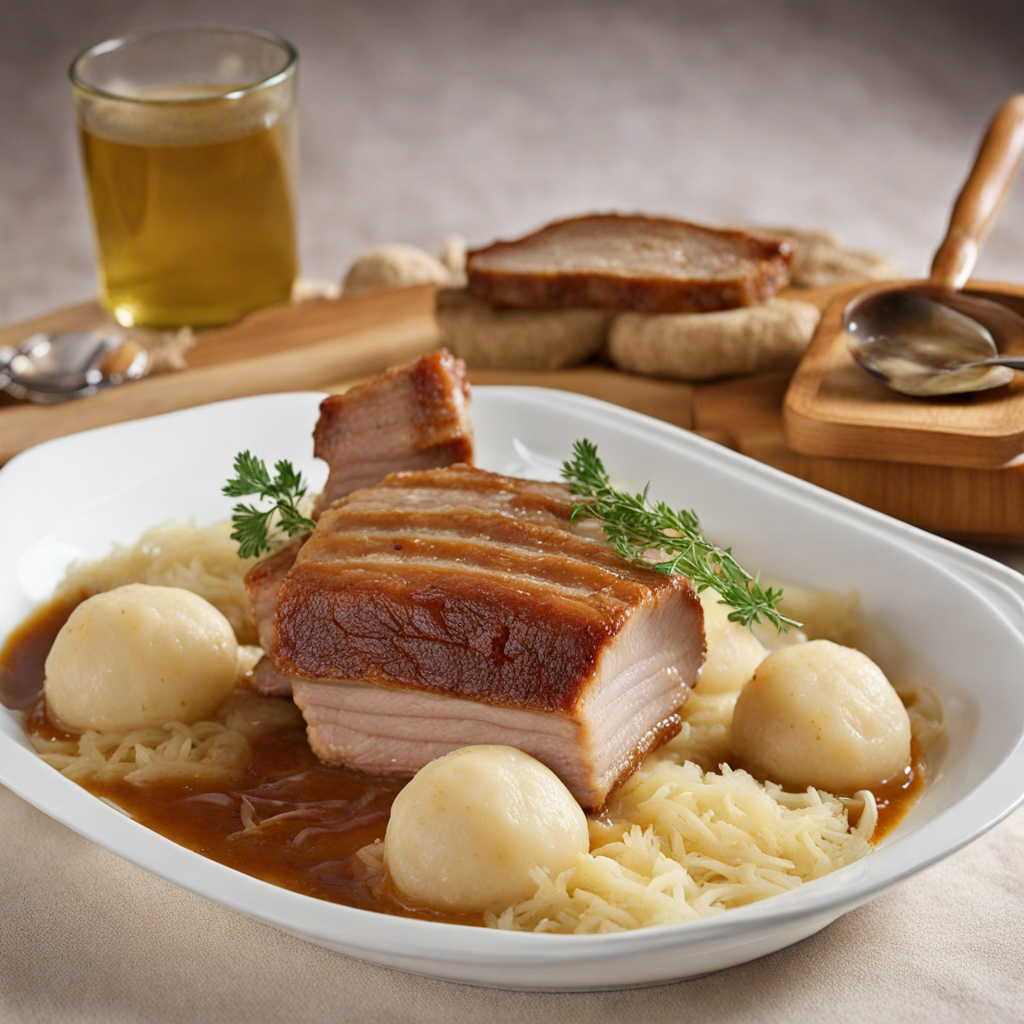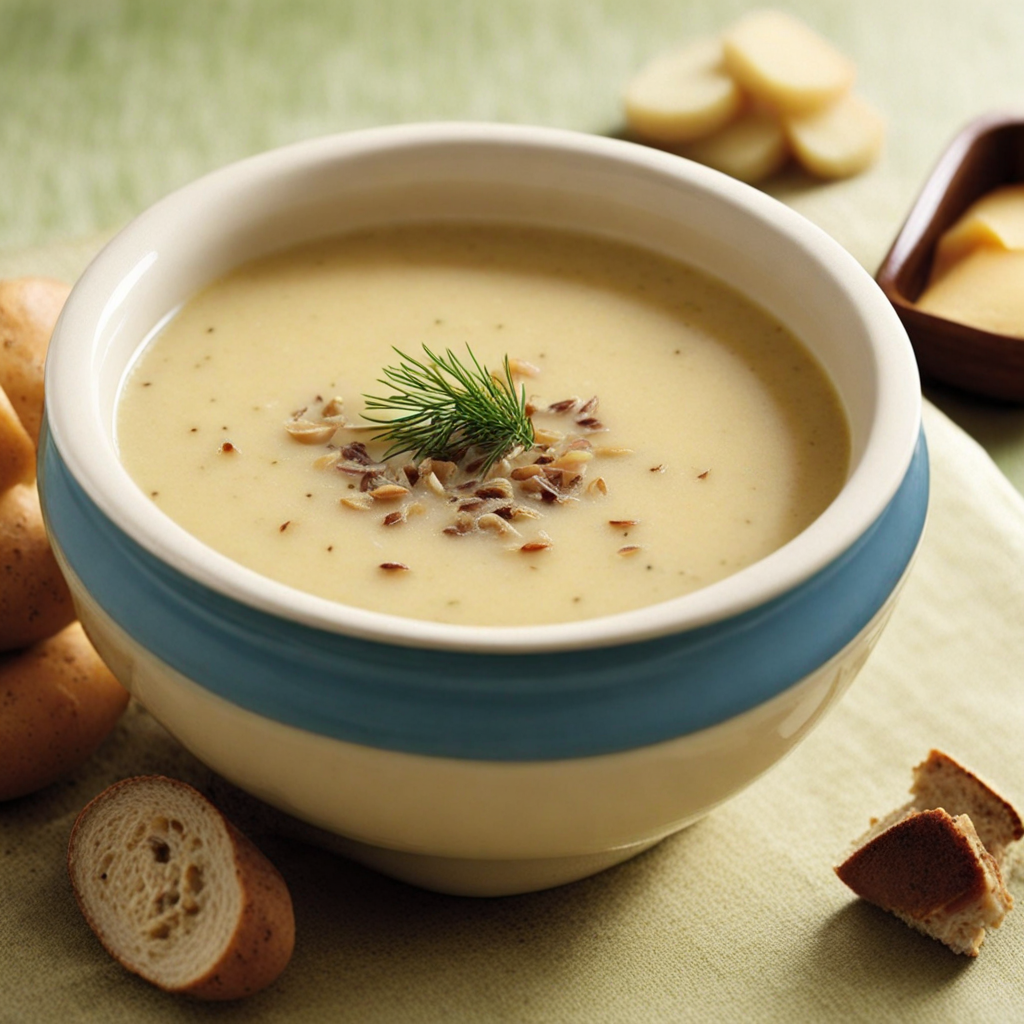Pork Belly with Sauerkraut
Pork Belly with Sauerkraut is a traditional Czech dish that beautifully balances rich flavors and textures. The star of the dish is the pork belly, which is slow-cooked until it becomes tender and succulent. The fat renders down, creating a crispy exterior while maintaining a juicy interior. This method infuses the meat with a deep, savory flavor that pairs wonderfully with the acidity of the sauerkraut, a fermented cabbage dish that is both tangy and slightly sweet, adding a refreshing contrast to the richness of the pork. The sauerkraut, made from finely shredded cabbage that has been fermented, contributes a unique depth to the dish. It not only enhances the overall taste but also provides a delightful crunch that complements the tender pork. Often seasoned with spices like caraway seeds, the sauerkraut brings a fragrant, earthy aroma that elevates the dining experience. Together, the two components create a harmony of savory and sour, making every bite a delightful exploration of Czech culinary tradition. This dish is typically served with hearty accompaniments such as dumplings or boiled potatoes, which help to soak up the flavorful juices. The combination of textures and flavors makes Pork Belly with Sauerkraut a comforting meal that reflects the rustic charm of Czech cuisine. It's a perfect representation of how simple ingredients can come together to create something truly special, inviting anyone looking to explore new tastes on a culinary journey.
How It Became This Dish
Bůček se zelím: A Culinary Journey Through Czech History #### Origins Bůček se zelím, a traditional Czech dish that translates to "pork belly with sauerkraut," embodies the heart and soul of Czech cuisine. Its roots can be traced back to the rustic kitchens of Central Europe, where the preservation of food through fermentation and curing was essential for survival through long winters. The use of pork, particularly the belly, reflects the importance of this versatile meat in Czech culture. Historically, pigs were an integral part of rural life in the Czech lands. They provided not only meat but also lard, which was crucial for cooking and preserving other foods. The tradition of pig farming and the communal pig slaughtering in late autumn, known as "zabijačka," allowed families and villages to stock up on provisions for the colder months. This practice is still celebrated today, often accompanied by festivities, music, and the communal preparation of various pig-derived delicacies. Sauerkraut, or "zelí," has its own rich history in the Czech Republic. Fermentation as a method of preservation dates back thousands of years, with the earliest records of sauerkraut consumption appearing around the time of the Roman Empire. The Czechs adopted this method, creating their own varieties of fermented cabbage, which became a staple alongside various meats. The combination of pork belly and sauerkraut created a dish that not only provided nourishment but also reflected the agricultural cycles and seasonal eating habits of the region. #### Cultural Significance Bůček se zelím is more than just a meal; it is a symbol of Czech identity and tradition. The dish is often associated with family gatherings and community celebrations, where it is served as part of larger feasts. It showcases the Czech ethos of hearty, wholesome food that brings people together. The preparation of this dish often involves family members gathering in the kitchen, sharing stories and passing down culinary knowledge from generation to generation. In addition to its familial significance, Bůček se zelím is tied to regional and national pride. Different regions of the Czech Republic have their own variations of the dish, adapting ingredients and cooking methods to reflect local tastes and traditions. For instance, in Moravia, one might find a sweeter version with added apples, while in Bohemia, it may be seasoned more robustly with spices. These regional adaptations enrich the cultural tapestry of Czech cuisine, illustrating the diversity within a seemingly simple dish. Bůček se zelím has also made its mark in Czech literature and folklore. It is often referenced in folk songs, tales, and even contemporary literature, symbolizing comfort and home. The dish embodies both the simplicity and complexity of Czech culinary traditions—the ability to turn humble ingredients into a nourishing and delightful meal. #### Development Over Time As time progressed, Bůček se zelím evolved alongside the Czech Republic's social and political changes. The 20th century brought about significant shifts in food production and consumption patterns, particularly during and after the two World Wars. Economic hardship led to a focus on frugality and resourcefulness, reinforcing the importance of traditional dishes like Bůček se zelím that utilized every part of the pig and made use of preserved vegetables. During the communist era, food became a tool of propaganda, with the state promoting self-sufficiency and traditional cooking methods. Bůček se zelím was often featured in cookbooks published by the state, emphasizing its role as a quintessentially Czech dish. However, the lack of variety in ingredients during this period led to a somewhat monotonous culinary landscape. Despite this, the tradition of preparing Bůček se zelím persisted, providing comfort and continuity to families amidst political and economic turmoil. The fall of communism in 1989 marked a new era for Czech cuisine. The influx of foreign influences and the rise of modern culinary trends began to reshape the culinary landscape. Chefs started exploring new techniques, ingredients, and presentations, but traditional dishes like Bůček se zelím remained a beloved staple. Innovative chefs began to reinterpret the dish, experimenting with flavors and presentation while still honoring its roots. In recent years, there has been a resurgence of interest in traditional Czech cuisine, driven by a broader movement towards local and sustainable food practices. Many chefs are now focusing on sourcing ingredients from local farms and preserving traditional methods of cooking. Bůček se zelím has found its way back onto menus across the country, often served in modern interpretations that highlight the dish's culinary heritage while adapting it to contemporary palates. #### Conclusion Bůček se zelím is more than just a dish; it is a narrative of the Czech people, woven through history, culture, and tradition. From its humble origins as a peasant meal to its status as a cherished symbol of Czech identity, the dish encapsulates the resilience and creativity of a nation. It serves as a reminder of the importance of food in connecting us to our roots and to one another. As the Czech Republic continues to evolve, so too will Bůček se zelím. It stands as a testament to the enduring nature of culinary traditions and the ability of food to reflect the stories of those who prepare and share it. Whether enjoyed in a bustling restaurant or a cozy family kitchen, Bůček se zelím remains a beloved dish that nourishes both body and spirit, celebrating the rich tapestry of Czech culture and history.
You may like
Discover local flavors from Czech Republic







